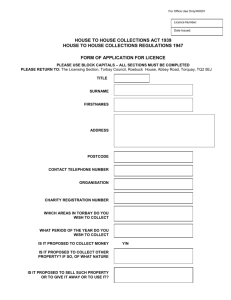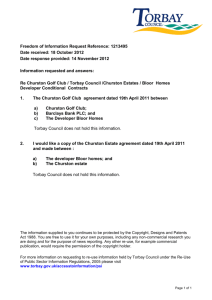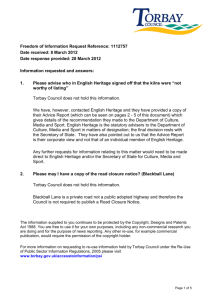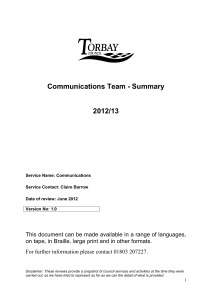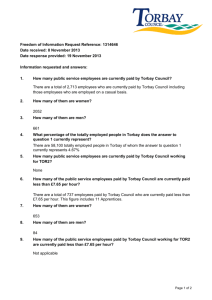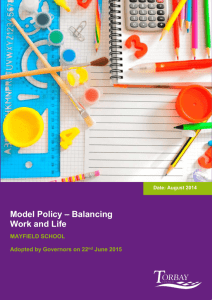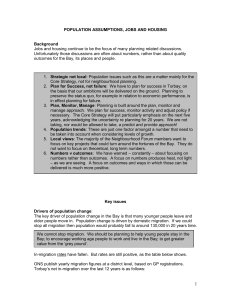Health and Safety
advertisement
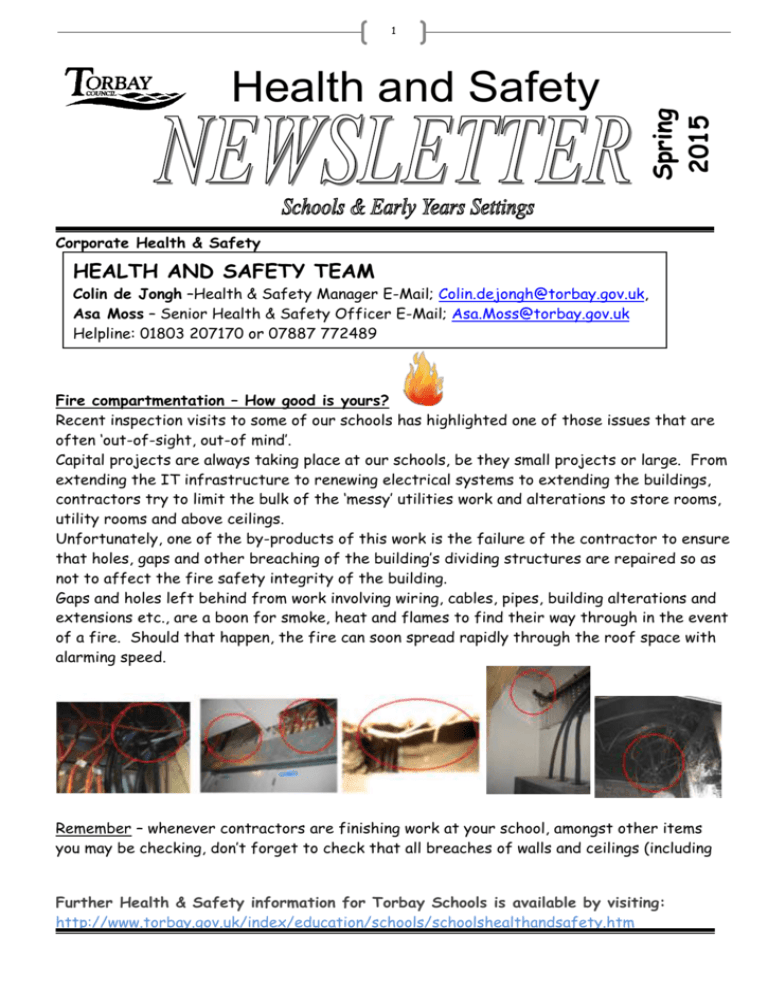
Health and Safety Spring 2015 1 Corporate Health & Safety HEALTH AND SAFETY TEAM Colin de Jongh –Health & Safety Manager E-Mail; Colin.dejongh@torbay.gov.uk, Asa Moss – Senior Health & Safety Officer E-Mail; Asa.Moss@torbay.gov.uk Helpline: 01803 207170 or 07887 772489 Fire compartmentation – How good is yours? Recent inspection visits to some of our schools has highlighted one of those issues that are often ‘out-of-sight, out-of mind’. Capital projects are always taking place at our schools, be they small projects or large. From extending the IT infrastructure to renewing electrical systems to extending the buildings, contractors try to limit the bulk of the ‘messy’ utilities work and alterations to store rooms, utility rooms and above ceilings. Unfortunately, one of the by-products of this work is the failure of the contractor to ensure that holes, gaps and other breaching of the building’s dividing structures are repaired so as not to affect the fire safety integrity of the building. Gaps and holes left behind from work involving wiring, cables, pipes, building alterations and extensions etc., are a boon for smoke, heat and flames to find their way through in the event of a fire. Should that happen, the fire can soon spread rapidly through the roof space with alarming speed. Remember – whenever contractors are finishing work at your school, amongst other items you may be checking, don’t forget to check that all breaches of walls and ceilings (including Further Health & Safety information for Torbay Schools is available by visiting: http://www.torbay.gov.uk/index/education/schools/schoolshealthandsafety.htm 2 those places above suspended ceilings) have been repaired and made good so that the building’s fire safety integrity is maintained. On-line Accident Reporting system - IMPORTANT NOTICE An addition to the on-line Accident Reporting system is the option to choose to record a Near Miss when logging a new incident. Previously there was only the choice of Personal Injury and Property Damage. The Health & Safety Executive (HSE) definition of a Near Miss is:- "an unplanned event which does not cause injury or damage, but could have done so." e.g. items falling near to persons, incidents involving vehicles and electrical short-circuits. Reporting Near Miss incidents is a very important way of identifying problem areas. It helps highlight some of the less obvious hazards in a workplace or identify areas where a problem is developing. Some models suggest that for every accident there are approximately ninety near-misses. A successful culture of Near Miss reporting means the hazard could be dealt with before someone is injured. First aid training - New nursery recruits The Dept. for Education have announced proposals that new nursery and pre-school staff will be required to undertake paediatric first aid for the first time. https://www.gov.uk/government/news/first-aid-training-to-be-made-compulsory-for-newnursery-recruits Children travelling in mini-buses Several recent enquiries about transporting young children, particularly in mini-buses, prompt this item and a reminder to schools of the law on this subject. The government guidance (Department of Transport) says ‘Minibus drivers and companies don’t have to provide child car seats. You must provide your own if you want to make sure a child has one.’ Further Health & Safety information for Torbay Schools is available by visiting: http://www.torbay.gov.uk/index/education/schools/schoolshealthandsafety.htm 3 It also says about Minibuses: ‘All children must travel in rear seats (i.e. any seats behind the driver) if a child car seat or an adult seat belt isn’t fitted.’ More detail can be found at https://www.gov.uk/child-car-seats-the-rules However, Torbay Council policy (via Outdoor Education policy - Devon & Torbay Outdoor Education, Visits and Off-Site Activities policy March 2014) does not allow children under 11 to travel in the front passenger seat of a minibus. It would be expected that LA schools would follow this policy. For Academies, it would be the school’s decision whether or not to adopt that rule. Transporting injured pupils We receive Accident/Incident reports showing that when a pupil has injured themselves and requires transporting home or to hospital, a member of staff has helped by taking the pupil to that location. This is in the absence of a parent/other adult responsible for the pupil not being available or instead of calling for an ambulance. It is recognised – and accepted - there may be circumstances when the school/college believes this action is appropriate. Three important factors should be part of the consideration: - It is recommended that all casualties when transported for medical treatment should be accompanied by the driver and an escort. This is in case of the casualty going into shock or passing out etc. They should be in the rear seat with the escort so as not to affect the driver should anything happen. - The presence of an escort adds merit to safeguarding measures. - The member of staff should have the appropriate car insurance cover for using their own vehicle for business purposes. Emergency Contact Numbers (Outdoor Education) The Devon and Torbay Councils’ Outdoor Education, Visits and Off-Site Activities Health and Safety Policy shows a landline 24 hour Emergency contact number in Section 3.9 Emergency procedures. In an emergency, LA schools and Academies who buy back into the Torbay Council Health & Safety service can also receive health and safety assistance from the Health and Safety team’s 24 hour Helpline number 07887 772489. Plaster of Paris (Design and Technology) Two recent enquiries from schools have been received regarding the use of plaster of Paris for producing full hand and arm casts. Further Health & Safety information for Torbay Schools is available by visiting: http://www.torbay.gov.uk/index/education/schools/schoolshealthandsafety.htm 4 CLEAPSS has produced a guidance sheet (PS74) on the safe use of plaster of Paris following two serious pupil injuries from its inappropriate use. Some key points: When mixed with water, plaster of Paris becomes extremely hot (exothermic reaction), expands slightly and sets hard. It is impregnated into bandage-type materials, known as Modroc. This makes it even stronger (just like reinforcing rods in concrete). There is a variety of trade names and the exact properties may vary slightly, depending on the formulation. It is not classified as hazardous. However, when water is mixed into large amounts of the plaster, the temperature can reach 60 °C. It could then cause a heat burn, but not a chemical burn. It is quite safe to make a plaster cast, for example, of a fossil, a shoe print or palm print. Splashes of the plaster on the hand can easily be washed off. It would not be safe to attempt to make a mould of a whole hand or encase any other part of the body. As the plaster hardens and expands, it is impossible to remove the hand which is flocked into place and gradually heated until it is burnt. If you wish to make a mould of the hand (or other body part) for the purpose of making a cast, the safest, fastest and cleanest material to use is alginate (a flexible, moulding compound sometimes used in dentistry). See CLEAPSS guidance sheet (PS74) HSE – Direct Window restrictor mechanisms Department of Health Estates have issued a new safety alert warning of the risks of using certain types of window restrictor mechanisms which when locked, can be opened with commonly available flat bladed instruments, as well as the ‘key’ provided. http://www.hse.gov.uk/safetybulletins/windowrestrictors.htm Concerns about blower-driven air to remove dust The Institute of LEV Engineers (ILEVE) and others have expressed concerns about the use of blower-driven air for removing dust, fibres, grit etc from clothing and hard surfaces. This is because of the danger of redistributing dust into a person's breathing zone. http://www.hse.gov.uk/woodworking/wooddust.htm?ebul=gd-woodworking&cr=3/Dec14 Further Health & Safety information for Torbay Schools is available by visiting: http://www.torbay.gov.uk/index/education/schools/schoolshealthandsafety.htm 5 HSE Myth Busters Challenge Panel The Health and Safety Executive has set up the Myth Busters Challenge Panel. This independent panel scrutinizes decisions where ‘Health and Safety’ is often incorrectly used as a convenient excuse to stop what are essentially sensible activities going ahead. Case 326 – Office lights must have a working bulb http://www.hse.gov.uk/myth/myth-busting/2014/case326-all-office-lights-must-havea-working-bulb.htm?ebul=hsegen&cr=5/03-nov-14 Case 327 – School staff banned from taking drinks onto the playground http://www.hse.gov.uk/myth/myth-busting/2014/case327-primary-school-staff-not-totake-drinks-onto-playground-during-breaks.htm?ebul=hsegen&cr=4/03-nov-14 Case 339 – School risk assessments to be re-done every year http://www.hse.gov.uk/myth/myth-busting/2014/case339-school-risk-assessments-tobe-redone-every-year.htm?ebul=hsegen&cr=6/05-jan-15 Safer Communities A new e-safety website for Torbay’s Virtually S@fe team has been launched. Visit www.torbayvirtuallysafe.co.uk to find information, advice and useful resources for anyone working with children and young people, parents or any young people who need to know more about being safe online. Safer Internet Day took place on 10th February. For more information, visit www.saferinternet.org.uk. You can also join in conversations on Twitter by following the Virtually S@fe team at @BeVirtuallySafe or use the hashtag #SID2015. Newsletters up-to-date on:http://www.torbay.gov.uk/index/education/schools/schoolshealthandsafety.htm as well as http://insight/index/information/riskmanagement/hs/hs-schools.htm Torbay Council Schools’ Newsletter What do you think about this Newsletter? Do you find it easy to read/useful/interesting/boring? What would you like to see contained in its pages? If you have any comments about this Newsletter together with positive suggestions as to how we might improve its contents, please let us know. An e-mail to either of the Officer addresses at the top of this edition would help us ensure we are doing our best to make this publication useful and of relevance to staff in our Torbay schools & Early Years settings. Further Health & Safety information for Torbay Schools is available by visiting: http://www.torbay.gov.uk/index/education/schools/schoolshealthandsafety.htm
